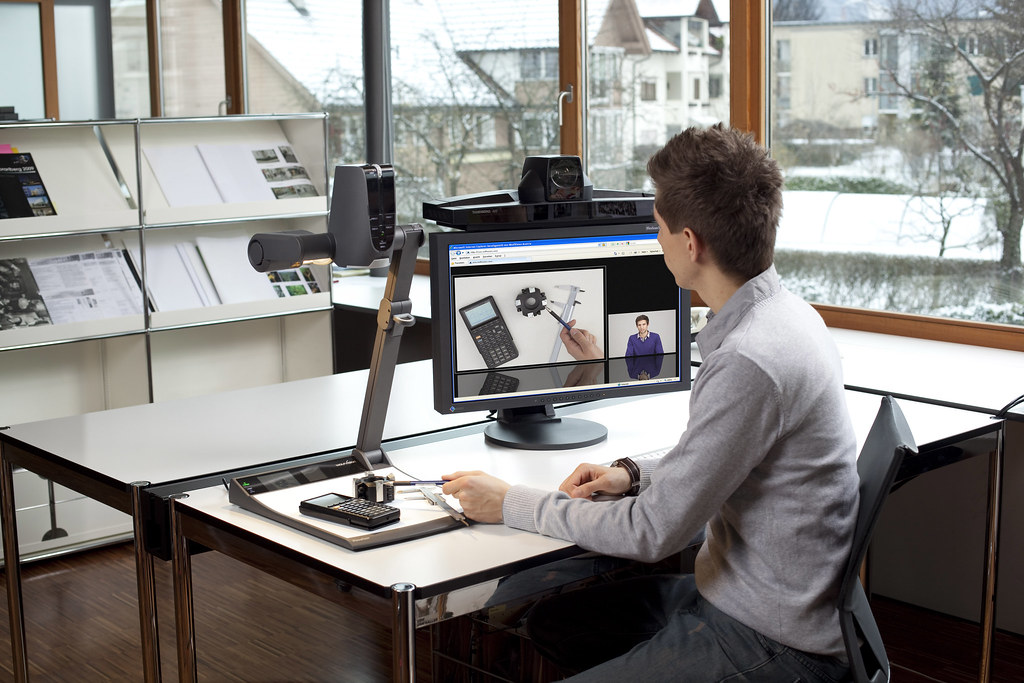Is visual collaboration as good as being there, or better than being there?
For many years, videoconferencing and collaboration firms have strived to achieve experiences that are “as good as being there.” With improvements in cameras, displays, codecs, and audio and video algorithms—not to mention easily available bandwidth—the collaboration experience has finally achieved that target.
What we’re seeing in our industry now are strides to surpass the in-room experience and produce something being referred to as “better than being there.” The easiest analogy to explain this level of experience is watching a football game on TV. In the football stadium, you would hear the roar of the crowd and feel the elements of the weather, while having only a distant view. At home, every TV viewer gets a close-up view of the action with superimposed markers on the field to show progress and downs. You get more from the TV experience than you get from actually being there.
“Better than being there” in collaboration could include artificial intelligence (AI) and machine learning (ML) to reject noise and improve the audio, or to frame camera shots automatically to optimize speakers and/or groups. Other features could include simultaneous, real-time translation and transcription; processors that produce multiple images to see more than one room view as multiple people talk; and analytics to understand participants’ emotions and interests instantly. Some of these already exist today, whereas others are contemplated for the future.
These features are just about the exact opposite of the “telepresence” craze of a few years ago, where the goal was for remote participants to be so lifelike that they seemed as though they were in the room with you—with no distracting technology elements.
So, as audio and video in collaboration continue to improve, what should our industry be striving for? Should we prioritize “better-than-being-there” experiences with (possibly distracting) high-tech elements, or should we prioritize life-size, telepresence-like experiences that have as few analytics and other distractions as possible? And how has the novel coronavirus (COVID-19) pandemic affected your thinking?
We asked a number of integrators, manufacturers, end users and service providers where they felt the industry was going; their answers are presented here. Feel free to read them with as few, or as many, features and/or distractions as you wish!
[Editor’s Note: Responses to this issue’s Viewpoint came in at the same time the COVID-19 pandemic was spreading. Some responses came in before we became aware of the scope of the crisis, whereas some came in afterward. Those that don’t mention it likely came in earlier.]
 INTEGRATOR
INTEGRATOR
Danny Rogers
VP, Global Channels
AVI-SPL
As introduction suggests, the peak years of telepresence are behind us, as demonstrated by the decline in demand for “immersive” room-based solutions, as well as a slowdown of traditional board/meeting rooms containing high-end video systems included.
But the manufacturers of these technologies should not fear—primarily because video has never been so widespread. Its use is now essential…a business and collaboration necessity. However, although usage has increased, the method of communication is changing rapidly, as are the prices of the cameras and video codecs.
Collaboration rooms and huddle spaces will remain a leading part of the AV market. Even though the average price of a conference meeting room has declined over recent years, the need for displays, cameras and general meeting-room equipment remains high.
It’s worth noting that the form factor for room-based video systems is changing, with a focus on simplifying the videoconferencing experience. This is demonstrated by new, purpose-built, all-in-one video bars from multiple manufacturers; these do not require an external PC or Mac to drive the experience. Put simply, it has never been easier to design, implement, support and use such solutions.
In addition to the above, the desktop battle among a short list of providers remains active. Many organizations are finding benefits in using third-party technologies to complement what’s being provided.
By incorporating some of these third-party solutions into a digital strategy, businesses can enjoy a best-of-breed video, voice and conference-room solution that complements their desktop solution.
The workplace of the future is no longer confined to static, physical offices. Businesses must ensure that they have a suite of collaboration tools that allows employees to work and collaborate efficiently. I think everyone would now agree that the AV-over-IP revolution is well underway; concordantly, collaboration technology is set to continue its development and growth as manufacturers continue to find ways to streamline and simplify both the IT manager’s experience and the end-user experience.
In terms of the key developments and changes within the AV space, one major factor is managed services. This factor is ever increasing because, as the workplace continues to get more sophisticated, companies and their staff require their AV, video and unified-communications systems to keep them connected and ready to collaborate and share content.
The main focus and features of today’s managed services respond to the connected workplace by giving organizations confidence that their systems are going to work when they need them to. This is all made possible by proactive monitoring and management of customers’ AV systems and videoconferencing equipment, as well as their supporting infrastructure. These services benefit the ultimate end users as well as the IT team that, now, can focus on core responsibilities.
A proactive approach provides the capability to watch over your AV systems, run diagnostics, launch video calls, and handle the way meetings are organized, monitored and managed—right down to the time systems are turned on and off. Additional benefits include a) improved productivity and reliability of systems; b) no need for end users to troubleshoot equipment issues; and c) video meetings happening on time and being monitored for quality.
 MANUFACTURER
MANUFACTURER
Brian Studwell
National Consultant Liaison
Mersive
As an industry, we need to strive to continue the positive perception that AV has gained by achieving huge improvements in audio quality, video quality and reliability. Although, of course, we will keep improving these elements, I think two areas of focus will bring us the greatest upswing in the perception of AV: a) tools to make the user experience easier, and b) tools to improve the amount of data collection and to make analytical outcomes easier to report. As we define and build “smart buildings,” tools that empower users to interact more easily with their space will be getting great attention.
Consider, for example, phone software that prompts a user, “Should I forward this call to the room you’re in?” Alternately, consider a prompt when a user enters a room enabling him or her to join a laptop videoconference service with the inbuilt room camera/audio. The idea is that the space will optimize the user’s communication based on where that person is and how the room is being used.
The second area in which we will see a huge uptick is the collection of data and the use of analytics. These will be used to validate expenses, manage spaces and improve productivity. It will be as simple as adjusting staffing levels based on meeting numbers or as aspirational as analyzing users use of voice, data and applications to determine the best meeting types and spaces.
 INTEGRATOR
INTEGRATOR
Vishal Brown
SVP, Enterprise Products
Yorktel
I would say, in many respects, it makes more sense not to be in in-person meetings! As we know, the idea of getting around to business partners and customers to have meetings sounds cool…until you appreciate the realities of actually getting to an in-person meeting. Let me take you through it.
First, there are all the logistics of finding a suitable day and time to meet with the party after they’ve already canceled twice. Either way, you finally book a flight (plus hotel) and leave the evening before to get there on time for a 9am meeting the next morning. All that for a meeting lasting all of one hour. One of the key meeting participants can’t make it, so, with no way to reschedule, you keep moving on. During the meeting, an urgent matter is raised—but it requires the participation of one of your colleagues (who didn’t make the trip). This results in an action-item follow up. On the way back, your flight is delayed, meaning you don’t get home to your spouse and kids until they’ve already gone to bed.
So, in summary, you lost an entire day for a one-hour meeting, and there are many action items and plenty of follow up for folks who weren’t present at the meeting. Plus, the company had to pay for transportation, plus the loss of productivity caused by that one-hour meeting. Lastly, you missed dinner and quality time with your spouse and kids.
Don’t get me wrong—I can appreciate a warm handshake and a good meal with a partner or customer. But, when you think about the tools available for us to communicate and collaborate versus actually “being there,” I know which one I would choose in most instances.
With the current COVID-19 pandemic impacting the world, there is a forced culture shift with the immediate mass adoption of work-from-home (WFH) collaboration tools. I would also argue that hardware manufacturers, software-as-a-service (SaaS) providers and network carriers are enabling the WFH crowd to bring the enterprise-conference-room experience to the home office.
- The Hardware: We now have high-resolution displays on our desks and high-resolution cameras on our laptops. High-fidelity speakers are now commonplace in many laptops, and they’re combined with echo-cancellation technology. Most importantly, laptops finally have the processing power to run these high-quality communication and productivity apps efficiently to deliver the experience typically found in the corporate conference room.
- Better Software: With the many cloud-based unified-communications-as-a-service (UCaaS) applications available, the WFH employee can have the same collaboration experience as someone sitting at his or her desk in an office. A big stride here, as well, is that UC-platform interoperability is now more commonplace. More importantly, the work-from-homer gets to take advantage of interoperability without having to be in the one corporate conference room where it works!
- Network: The fact that we can stream 4K consumer content to our living rooms means that WFH employees have more than enough bandwidth to be effective on video calls with their colleagues.
- Better UX: Lastly, the user experience (UX) is much improved, with one-touch capabilities on communication-and-collaboration applications making the “join” experience very user friendly.
The challenge for service providers is having the ability to monitor and manage the collaboration experience of both users in the corporate conference room and users at home. With life-changing events like COVID-19 forcing work to become an activity and not a destination, it pushes managed-service providers to reimagine their value proposition to managing the collaboration experience of users in their home offices.
 MANUFACTURER
MANUFACTURER
Michelle Loret
Regional Sales Manager
Kramer Electronics US
The recent COVID-19 pandemic has pushed videoconferencing to the forefront of the average layperson’s consciousness. In the past week, I’ve read over a dozen articles explaining it, watched videoconferencing stocks soar, and seen parents and teachers scramble to adopt it as schools close for the foreseeable future. This is videoconferencing’s time to shine as it transitions from a “nice-to-have” to an essential tool. But where do we go from here? What’s missing that would further enhance the user experience?
As I participated in a 35-person virtual lunch sponsored by the IMCCA yesterday, it occurred to me that having the ability to break into sidebar conversations natively would be a welcome enhancement. The ability to break out subgroups quickly and then rejoin the main call could improve both participation and the value of the meeting. I see a potential benefit in corporate, research and classroom applications with the increase in working from home.
At the lunch, we discussed the albatross of proper eye contact with participants. I was surprised to learn in my research that Intel has already leveraged deep convolutional neural network (CNN) technology to address this shortcoming and redirect a person’s gaze by warping and tuning eyes in its input frames. The outcome is the perception that the person is looking directly into the camera and, consequently, at you when they’re actually not. It seems logical that this feature set will be integrated into most platforms eventually.
With the trend toward software-based videoconferencing solutions, there has been explosive growth in hardware specifically designed to support the soft-conferencing ecosystem. As videoconferencing continues to evolve, there will be a similar synergy with third-party plugins, very much like the plugins used in software-based audio and video editing. This will allow videoconferencing users to customize the standard application to their needs.
We have concentrated on making videoconferencing as good as being there, and the COVID-19 pandemic has highlighted the fact that, sometimes, we cannot be there. The next iteration of videoconferencing will be about bringing exceptional experiences to those who aren’t physically present. As the trade-show industry reels from the domino effect of cancellations, there is an unprecedented opportunity that lies before us. It started as a hashtag joke two years ago (#NonComm) for those unable to attend InfoComm. Last year, it resulted in the HETMA online conference for higher-education professionals. The next step is some level of virtualization, enabling remotes attendee to self-curate their experiences: walk, see, discover and explore a booth, then interact with professionals to have questions answered through conferencing.
The technology is at a level at which the technical and connectivity issues of the past have largely been overcome. The future is about making the experience seamless and human-centered. The question to ask is, “Are we prepared for our moment in the sun?”
 END USER
END USER
Gary M. LaSasso
Director, Collaboration Experiences & Technologies
Amicus Therapeutics, Inc.
I’ve spent a lot of time thinking about this question recently because what you’re really asking is this: What is our collaboration strategy over the next three to five years? For our firm, our collaboration strategy is to connect every employee securely—in any place, at any time, on any device. To understand if and when it is time to implement these enhanced capabilities, it is best that we first understand our end users and the types of meetings that we hold as an organization today. Collaboration among our scientists is certainly different from collaboration among our finance team. For that reason, I don’t think we have seen the end of “telepresence.” There remains a need for high-level, executive-type meetings in our industry, but the percentage of these meetings is decreasing rapidly.
The vast majority of our meetings are not immersive executive meetings, but, rather, functional, day-to-day communications between individuals and small groups. These meetings don’t require life-size images with no technology intrusion. As many have said, “they just have to work.” For these meetings, it’s clear that the genie has been let out of the bottle: artificial intelligence (AI) and machine learning (ML) are here, are amazing and aren’t going away. But just because manufacturers and service providers make them available doesn’t necessarily mean that we have to adopt them right now. Most of these enhanced capabilities are still in their infancy, and they’re not quite ready for prime time.
Although there is much room for improving these capabilities, we as end users need to know which of these enhancements will have a positive impact on the meeting experience. We have to be prepared to roll them out when they add value to the meeting experience—and when they’re not a distraction from the actual meeting experience.
We already have enough distractions in meetings today. For our organization, real-time translation and transcription, noise filtering and improvements in camera framing would be value-adds that we really could use—the collaboration equivalent of the digital first-down markers on football broadcasts. Other suggested features, such as measuring emotions of attendees, will go over like a lead balloon: think of the glowing hockey puck Fox introduced in 1996. As new features are added, we will continue to evaluate each one with both excitement and skepticism.
 END USER
END USER
Michael Duda
AV Deployment Program Manager
Google
Recent events have shown us that we are no longer bound by an experience in a conference room in our office. Unified-collaboration solutions need to deliver at home, on the road and anywhere in between.
And although my philosophical side says this does not need be an oppositional dichotomy, I’d be remiss not to call out that, in our trying times of working remotely, telepresence-like experiences fail to deliver. Given today’s challenges, call quality, in-room experience, and scalability to remote and mobile platforms should be prioritized in the user journey of every collaboration manufacturer. To that end, on-premise, high-end collaboration experiences will continue to have their place—they’ll just likely be less common.
Features such as translation and transcription, auto-zoom, analytics, etc., should be available to all who want them—but as an add-on to reliable, seamless, easy-to-use platforms that are available to as many people as possible. Platforms also have to allow telephone bridging if bandwidth for rich media is not available.
There should always be easy-to-access pathways to ingest feature requests from end users, and they should be reviewed for impact during regularly scheduled cycles. A dedicated team of engineers that works to release those through proper change-request cycles and programmatic-review cycles must be managed by program managers who curate the timeliness and delivery of those efforts commensurate with their priority. Excellence is at stake.
Simply put, the experience has to be as good as it can be in terms of quality (audio, then video), as wide reaching and adaptable as possible, and super scalable. New features should be evaluated for applicability, but only rolled out a) if they don’t compromise quality and the reliability of the basic experience, and b) after sufficient stability validation.
 MANUFACTURER
MANUFACTURER
Wayne N. Driggers Jr.
VP of Product
Aver
As with any decision being made in the enterprise today, choice is the most-requested option. This choice is for both the IT/AV decision-maker and the end users who will ultimately use the tools that they feel are best. The football analogy is a great one; however, it implies an “either/or” scenario. Many solutions are close to providing both an immersive-room option and a virtual-attendee option as part of their platform or ecosystem.
With the increase in adoption seen prior to recent events, it would be fair to say that end users are opting more for the virtual-attendee option. The many choices available to the virtual attendee provide a more productive meeting experience. Virtual attendees can actively prepare their next content/statements without having to be fearful of violating meeting etiquette—something that’s inherent to an immersive room or a physical meeting room. Typing, paper shuffling, chatting, research, third-party tool access and any other action can be completed behind the “video/audio mute barrier” that hides the excess noise or motion of these actions.
Connecting remotely with meeting attendees to solidify positions and data pre-meeting, no matter the location, is another beneficial component of the virtual-attendee option.
 SERVICE PROVIDER
SERVICE PROVIDER
Karl Hantho
President, Americas
Pexip
Our firm believes that virtual meetings can be just as effective as in-person meetings can be, helping users be productive and effective wherever they are located. With an unprecedented number of employees working from home as a result of COVID-19, there is a heightened awareness that virtual meetings must be simple to schedule, host and join. Users have to be able to join meetings with familiar devices and workflows—whether a web browser, laptop or mobile device—and navigate the conference controls simply and easily.
New technologies like artificial intelligence (AI) can bring people to the heart of the meeting experience, and they’re a great example of removing complexity to create a simple user experience. Using real-time facial detection, auto-framing and an optimized use of screen real estate can empower people to engage with each other in a better way, regardless of how they join the meeting. Since the meeting experience is device-agnostic, it gives everyone—from the conference room to the home office—a great experience.
For virtual meetings to be as effective as in-person meetings, the ability to meet with anyone is critical; one of the biggest barriers to virtual meetings has often been interoperability. Users are invited to meetings hosted on a variety of platforms, and they have to have the ability to join those meetings, whether internally or externally, regardless of platform. These abilities—not immersive experiences—are what have been evolving at an accelerated rate in recent years. By simplifying the user experience (and delivering a powerful enterprise-management experience), we can make virtual meetings just as effective as in-person meetings. In summary, it’s our opinion that the priority is to ensure that every person is seen, heard and included.
For more IT/AV-related posts from Sound & Communications, click here.
